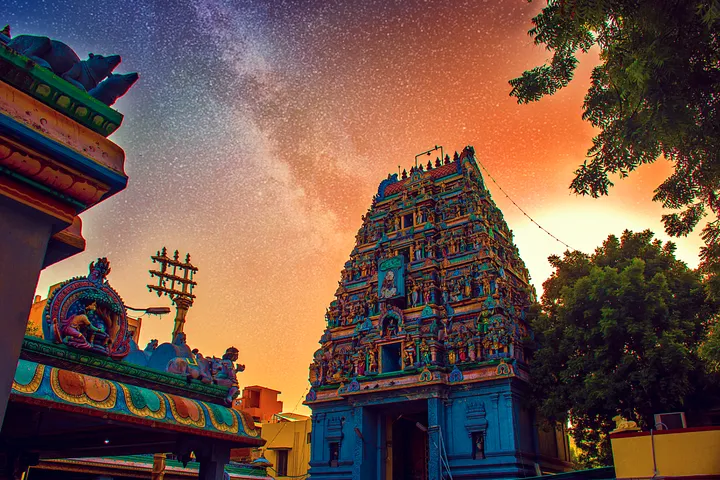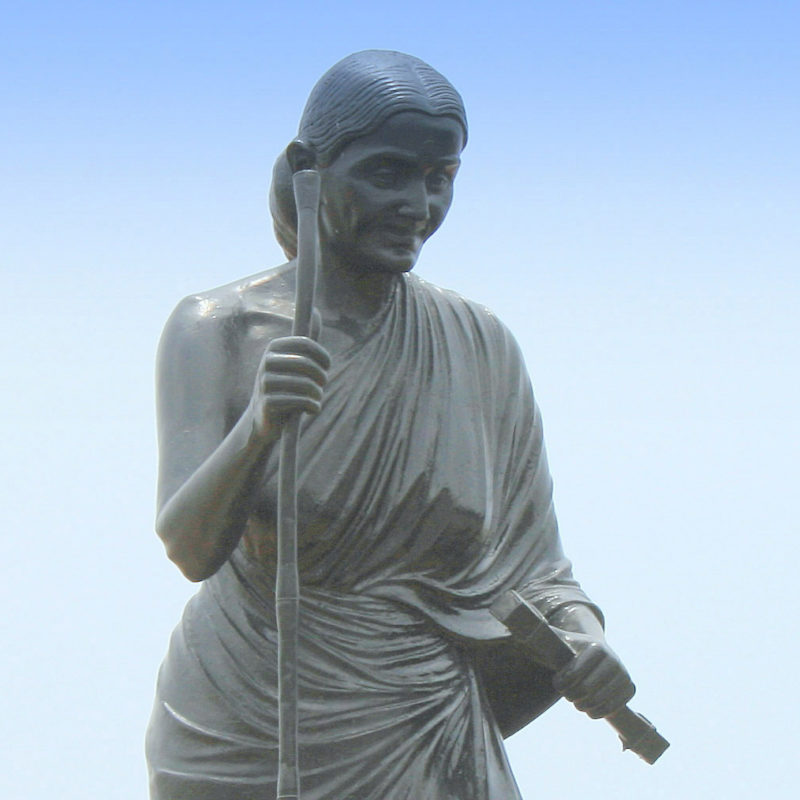
The holy month of Karthikai is upon us and we Tamils celebrate the special festival of Karthikai Deepam or Dev Diwali or Tiruvannamali Deepam by lighting small earthen oil lamps all over our houses and temples.
This festival is celebrated on the first full moon day or purnima of the Kartikai month. Apart from the worship and celebration of Lord Kartikeya’s birth on this day, another important reason is that on this day Lord Shiva manifested as a mega pillar of fire or deepam above the Tiruvannamalai or Tiru temple in the temple town of Tiruvannamalai in Tamil Nadu, in southern India.
In honor of that holy manifestation, a massive earthen lamp known as Bharani deepam is lit in the Arunachaleshwar sannidhi ( sanctum sanatorium) in the Tiru temple. Subsequently, Tamil homes all over the world light smaller deepams. Every year when I celebrate Kartikai deepam, I can’t but help remember my visit to the grand Tiru temple many years back with my daughters.
My daughters and I visited this temple during our gap year in India from 2019–2020. This post is my unique way of celebrating, honoring my motherland, and expressing my devotion to my Ishta Devata or favorite deity.
Visiting the Tiru temple had been on my wish list, with my heart yearning for it. Finally, thanks to my dad, I had found a way to soak in the incredible spiritual and cultural environment that all the glorious temples in India provide.
He took us on a beautiful road trip in Tamil Nadu, from Kovai to Tiruvannamalai via Salem and back to Kovai through another temple town of Namakkal dedicated to Lord Hanuman.
The temple in Tiru is dedicated to Lord Shiva, known as Annamlaiyar or Arunachala Shiva Shiva, and was built by the famous Chola kings. The Chola dynasty is one of the world’s most prosperous, longest-ruling dynasties, with remarkable, outstanding contributions to Tamil culture and Indian history.
The Tiruvannamalai temple is one of the largest temple complexes in India
The gopurams or temple towers, are one of the tallest in Asia. They are grand and beyond one’s limited imagination.
https://www.templetravel.info/2016/09/arunachaleswaraannamalaiyar-shiva.html
I recollect feeling immense excitement as soon as we exited our car.
Everything about temple towns makes me SO alive.
 Hindu temples in India have an active ecosystem thriving around them that stirs all your senses, jolting you back to the “here and now” before you step inside the place of worship. They serve as a significant means of employment for all those working in the temple and those selling every accessory or medium the devotee deems necessary for worship.
Hindu temples in India have an active ecosystem thriving around them that stirs all your senses, jolting you back to the “here and now” before you step inside the place of worship. They serve as a significant means of employment for all those working in the temple and those selling every accessory or medium the devotee deems necessary for worship.
The streets leading to the main gopuram or tower were lined with many tiny shops selling incense sticks, flower garlands, and fruits that devotees like to offer for murti puja .

The flower garlands, especially, are always a sight to admire.
It’s ideal to pause everything around you and watch the quick, deft ways the flower vendor makes the garland. These guys are some of the best multitaskers I’ve seen. They have perfected the art of combining many floral shapes and textures into a compact form that can adorn the murti while directing others in their shop or communicating with the customers. It feels akin to bringing all the different aspects of our personality into one focus to further direct it to the Supreme Self or God within us.
How can we be alive and interact every moment with the world around us while also being intimately in touch with God?
Huge roses, fragrant jasmine, leaves, and all sorts of local flora and fauna are used in making these garlands. One can also hear the temple bells ringing loudly in the background. Not to mention the dogs, the cats, the cows roaming around, and all the little birds, especially sparrows chirping and flying around.
After all, every creature is equal in the eyes of God.
The entire cosmos, it felt, was preparing me for my rendezvous with the Supreme Self!
I generally buy something at the local shops to support the local ecosystem. We love the opportunity to buy garlands made of kanakambaram flowers to adorn our hair.
South Indian women are big when decorating and beautifying their hair with flowers. One can be spoilt with choice, but the tiny bright orange flowers of the kanakambaram weave more magic on us than the jasmine and roses. Maybe because they are unavailable everywhere or because their deep, rich color can mesmerize the onlooker? Maybe because they are indigenous to South India and reflect our unique selves? We never know!
We were thrilled to wear the exotic flowers again and bought other garlands and fruits for our murti puja.

Finally came the time to step inside the vast temple!
I still remember my heart beating wildly, with goosebumps all over my hands as I stepped into the temple.
Has my soul been here in many different births and forms? I had the contradictory and exciting experience of disbelief and shock while feeling totally at home, like I had arrived where I truly belonged!
 Stepping into the temple felt magical, majestic, and profoundly moving simultaneously
Stepping into the temple felt magical, majestic, and profoundly moving simultaneously
Temples in India have this unique vibe of devotion and direction to everything above and beyond mere, mortal human life. It is an acknowledgment of how and why we are created in the first place- to seek the divinity within us and to experience it outside.
The Tiru temple complex is especially so magnificent that it will take your breath away. Leave you stunned and at a loss to understand how such brilliantly large complexes were built in ancient times without modern machinery. India’s temple architecture needs to get the praise and attention it TRULY deserves.
The Tiru temple, for example, was built sometime in the ninth century with precise knowledge and expertise dictating everything from the exact location, symmetry, and architecture to the layout. It’s a highly specialized science and art called the Agamas.
All temples in India signify some aspect of the pancha mahabhutas (five elements of nature), and this particular temple is dedicated to the fire element. Four other important Shiva temples across India signify the other four elements: water, air, earth, and space. Usually, a pilgrimage would constitute a visit to all the temples that signify the five elements that all creation is made of. We, of course, were visiting only this one.
Once inside the temple complex, we took our sweet time to admire the intricate carvings on the gopuram (temple tower) and feel our insignificance. How many lives have come and gone, and how do these towers stand, witnessing the passage of lives like they mean nothing?
Hinduism believes in the continuous cycle of birth and death till the indestructible soul within becomes one with the Supreme Self that created it.
And there is nothing like huge towering gopurams above you and the deity they house within to remind you of your temporary !

Ancient temple architecture was meant to bring down your ego and make you aware of how dispensable you can be. Right? After all, the first step to devotion is sensing your vulnerabilities, and what can be a more deep vulnerability than knowing that all this will end someday?
I also immensely liked the 1000 tower hall. Walking through it feels like a prep to experience what’s ahead: the sanctum sanctorum or sannidhanam where the main murti, Arunachala Shiva, is housed. The Supreme Self is manifested in the form of the Shiva Lingam, one of the prominent ways of representing HIM.

Those who use the Shiva Lingam see in it a symbol of fertility: the phallus representing the male and the egg the female. Together, they represent the fundamental creation of life and of Nature itself and a fundamental spiritual balance- Das, Subhamoy. “The Real Meaning of the Shiva’s Linga Symbol.” Learn Religions, Sep. 9, 2021, learnreligions.com/what-is-shiva-linga-1770455.
My favorite symbolism of the Shiva Lingam is ekam — oneness with the Supreme Being and its creations being the ONLY truth. Everything else in its absence is shoonyam (zero) without it.

After worship at the main sannidhanam, we sat to soak in everything around us. There was a flurry of devotees back and forth, a calf and some dogs trotting around. This temple didn’t have monkeys, but it’s common to see these animals and many others, like goats, turkeys, birds, hens/roosters, and snakes. Very common. All beings are permitted to be in a temple.
Who are we to judge who can or cannot experience the divine in a temple?


An oorvalam (procession) also passed through with all the accompanying drums, cymbals, flutes, and chanting. It’s common in temples to move the murti around to places outside the temple for those who can’t make it to get a darshan of the murti. These public religious processions are significant events in the temple that happen daily in a small capacity or massive forms with thousands of devotees and elaborate celebrations.
 As we sat in the corridors and decided to indulge in the yummy prasadam, I saw many South Korean women. I could easily distinguish the language from all the South Korean dramas I watch. Yes, I’m a massive fan of K-drama. I approached them, and we chatted about our love for everything India, Hinduism, Shaivism, K-drama, and South Korean culture.
As we sat in the corridors and decided to indulge in the yummy prasadam, I saw many South Korean women. I could easily distinguish the language from all the South Korean dramas I watch. Yes, I’m a massive fan of K-drama. I approached them, and we chatted about our love for everything India, Hinduism, Shaivism, K-drama, and South Korean culture.
Sri Ramana Maharshi – Your real nature is happiness
These women were devotees of Ramana Maharishi, one of South India’s revered saints, who dedicated his life to his spiritual development and devotion to Lord Shiva. Who knew that Ramana would have so many South Korean followers?
Everything about that visit remains etched in my memories. Every little detail. We all came out feeling so satisfied and equally amazed at the experience. Not to mention grateful, blessed, humble, and in touch with ourselves and our divinity.
Nothing like a massive temple complex to give you a sweeping tour of everything within and without. To me, it’s like a space odyssey where you can’t help but admire the grandeur of it all and be thankful for everything you have.

You are mystified, challenged, and grounded!
Since the day, I stepped into the Tiruvannamalai temple, I have become an ardent devotee of Arunachala Shiva.
HE has captured my heart and soul and remains my Ishta Devata. As part of my spiritual practice, I meditate upon the chants of Arunachala Shiva most mornings.
Want to know more about the magnificent temple of Tiruvannamalai?
Small visual tour:
https://youtu.be/GCpbN0QutBw
In-depth tour and explanation:
https://youtu.be/UuE7c-dbJ6w
Om Namah Shivaya!







































